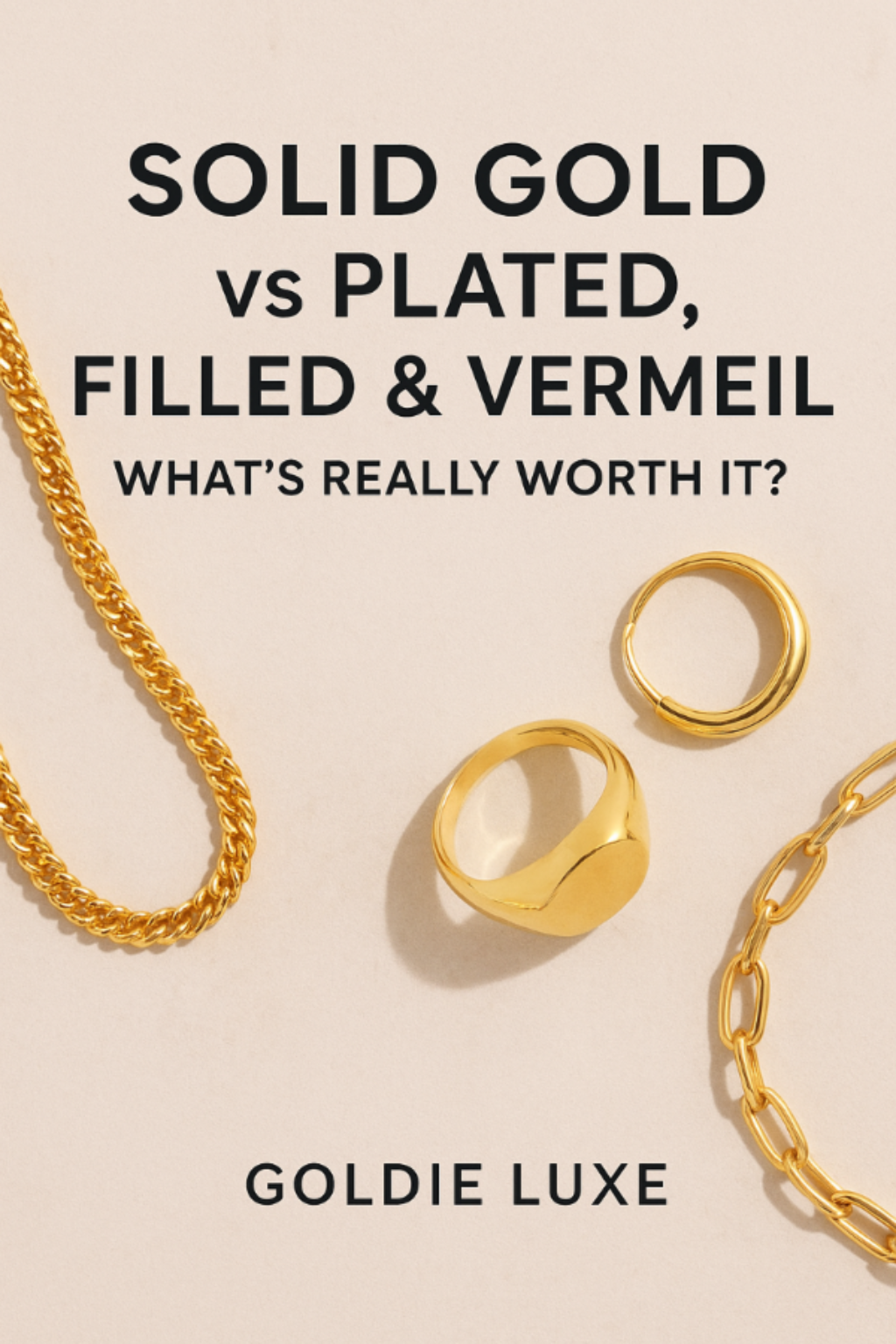
Stop Guessing: Plated vs. Solid Gold - The Ultimate Guide to 18K Jewellery
Share
The 18K Gold Trap: Why You're Overpaying for Jewellery That Won't Last
A Goldie Luxe Expert's Guide to Plated vs. Solid, and why we believe 18k Solid Gold is the best investment you can make in fine jewellery.
The gold market operates on a subtle deception: Many pieces labelled "18K Gold" are simply a fleeting veneer. You pay for the luxurious look of gold but get zero longevity or real asset value.
At Goldie Luxe, we believe true luxury is an asset. This guide cuts through the marketing noise to show you exactly what you’re buying in the name of 18K gold, and why one option is the only true heirloom.
The Gold Standard Hierarchy: Five Types, One Destination
The crucial difference is not the colour, but the underlying structure. This structure determines durability, skin safety, and long-term financial worth. Four options lead to disappointment; only one leads to an enduring legacy.
| Gold Type | Base Metal | Gold Content (by weight) | Durability & Lifespan |
| Plated | Brass, Copper | Miniscule (<0.05%) | Very Low (Wears off in months) |
| PVD Plated | Stainless Steel | Very Low (Molecular Bond) | Low (Better than Plated, still a layer) |
| Vermeil | Sterling Silver | ≥2.5 Microns (Thick Coating) | Moderate (Temporary, requires replating) |
| Gold Filled | Brass Core | ≥5% (Pressure Bonded) | High (Long-lasting, non-reactive) |
| Solid 18K | 75% Pure Gold Alloy | 75% (Gold all the way through) | Ultimate (Never Fades, Lifetime Guarantee) |
The Fatal Flaw: Why Temporary Gold Fails
The first four options are surface-level solutions. They offer a beautiful look for a fraction of the cost, but they are built to sell, not to keep.
The Plated Promise vs. The Reality
- The Problem: All plating, even the high-tech PVD, is designed to be expendable. Friction, chlorine, hand sanitiser, and even your skin's natural oils will inevitably erode the gold layer.
- The Result: You are left with a tarnished, worthless piece of base metal (often nickel or brass) that can cause allergic reactions and skin discolouration.
- Vermeil's Advantage: Vermeil is the premium coating because of its Sterling Silver base and 2.5 micron thickness. It's the best choice for occasional, sensitive wear, but it still has an expiry date.
Gold Filled: Durable, But Not Divine
- The Catch: Gold Filled has great durability because the gold makes up at least 5% of the weight. However, because it's a permanent bond, it cannot be sized, repaired, or polished without cracking the gold layer.
- The Conclusion: It’s a long-lasting accessory, but it is not fine jewellery and cannot be appreciated as an asset.
Solid 18K Gold: The Ultimate Investment and Heirloom
When you choose Solid 18K Gold, you are investing in a 75% pure asset. The 18 parts of gold (mixed with 6 parts of alloy for strength) provide a guarantee that no other type of jewellery can match.
- Financial & Emotional Value: It lasts forever. It will never tarnish, fade, or require re-plating. It retains its 75% gold value, making it a reliable asset.
- Unrivalled Purity & Health: Being 75% pure gold, it is the safest, most hypoallergenic option on the market. It eliminates the risk of reactions caused by base metals like nickel or copper.
- Unrestricted Living: You never have to take it off. It is pool-proof, shower-proof, and life-proof. Your daily habits won't erode its beauty.
- The Art of Repair: Any skilled jeweller can polish, size, and repair a solid gold piece indefinitely, restoring it to its original glory. It is a material built to be serviced, not replaced.
The Goldie Luxe Verdict: If you are buying gold to celebrate a milestone, invest in your personal style, or create an enduring legacy, Solid 18K Gold is the only choice. Stop paying for temporary sparkle. Invest in permanent brilliance.
FAQ: Expert Answers to Final Questions
Q: Why is 18K believed to be the best karat for fine jewellery over 9K, 14K, 21K, 22K, or 24K?
A: 18K (or 75% pure gold) is considered the perfect balance of purity, durability, and colour for fine jewellery:
| Karat | Purity (%) | Pros | Cons | Why 18K Wins |
| 9K | 37.50% | Very durable, lowest cost. | Low gold richness, highest chance of allergy due to base metals. |
Too low in purity for luxury appeal and skin safety.
|
| 14K | 58.30% | High durability, standard choice. | Less vibrant colour than 18K, lower asset value. |
18K offers richer colour and higher intrinsic value without sacrificing necessary durability.
|
| 21K / 22K | 87.5%/91.7% | Extremely rich, deep golden colour. | Too soft for gemstone settings and daily wear (easily scratches/bends). |
18K provides the ideal hardness to protect stones and hold shape.
|
| 24K | 100% | Purest gold, highest asset value. | Exceedingly soft—will scratch, dent, and deform with one day of wear. |
Not suitable for jewellery; reserved for bullion (bars/coins).
|
In short: 18K gives you maximum golden colour and value while still being hard enough to last a lifetime.
Q: Is 18K solid gold safe for highly sensitive skin?
A: Yes, absolutely. Since 18K gold is 75% pure gold, it is highly non-reactive and the safest, most hypoallergenic option available. The high purity shields your skin from the alloys that typically cause irritation in plated or lower-karat pieces.
Don't settle for the temporary sparkle. Invest in pieces that are built to outlast you.